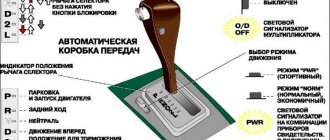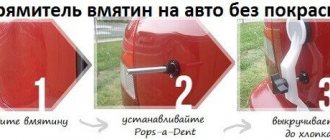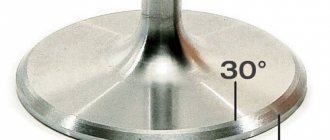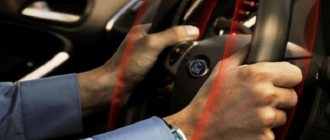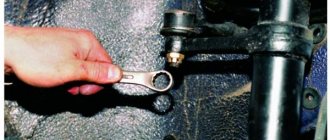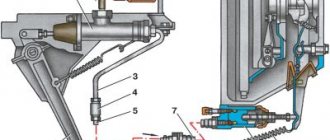Many beginners complain that despite an intensive training course in driving schools, lessons from excellent instructors and friends, and passing the driving test, they still face problems with correct steering. Not everyone knows how to turn the steering wheel correctly and very often find themselves in an unfavorable situation. Knowing the correct steering technique not only helps you cope with difficult road situations, but also contributes to the development of professionalism. We will try to tell you in detail how to drive correctly on the pages of this article, regardless of your driving experience and car make.
Effective social advertising, informing about the need to hold the steering wheel under any circumstances.
Basic beginner mistakes
After receiving a license, many newly minted drivers relax: they forget about proper seating in the seat, place their feet on the pedals incorrectly, and, of course, neglect the correct grip of the steering wheel. They quickly develop a sense of false confidence and the ability to control the situation. At the same time, manipulations with the steering wheel are performed in completely different ways - from sharply jerking the steering wheel to steering with one hand and even just with your fingers.
Also among the most common errors are “hanging” on the steering wheel, “death grip” and driving with straight hands. Meanwhile, there are basic rules that help you really control the situation, drive the car straight, without “wobbling,” take turns safely, and competently master driving backwards.
How long does it take to learn to drive?
The question is very interesting. Everything, of course, is individual and depends on many factors: first of all, on age. But on average - from several months to... Until an indefinite period.
I would divide the learning process into two stages. The first is before obtaining a driver’s license, which usually takes place under someone’s supervision. The second is independent “swimming”: most often, immediately after obtaining a license. It starts with the first trip without a mentor.
The duration of the first stage, as a rule, is regulated by the driving school program and is slightly less than 50 hours. It seems to me that this is quite enough to prepare for the traffic police exam. But in order to drive independently and confidently, such a number of lessons is not enough.
If everything is more or less clear with the first part of the training, since it takes place under the control of the instructor, then responsibility for the second rests entirely with the student himself. And this is the most important moment in the life of any motorist.
During this period, there are a great many new and difficult situations on the road, and the skills developed are still not enough. At other times, anxiety reaches its limit, since there is no one to advise and correct at the right moment. The new driver must make his own decision and learn another “lesson.” But it is precisely this kind of “study” that allows you to accumulate the necessary experience. And only from this period the real driving experience is counted.
Personally, it took me at least six months of daily driving for me to feel confident behind the wheel. On a car with an automatic transmission, this period is shorter: sometimes several times.
However, be careful: imaginary confidence behind the wheel and a deceptive sense of control over the situation are dangerous enemies of the driver - and not only the beginner. Unfortunately, a feeling of confidence is not yet a sign of skill and professionalism.
In fact, the driver is learning the entire time he is behind the wheel. There are an infinite number of tasks on the road, and ready-made solutions for all occasions simply do not exist. But in a few months of daily trips it is quite possible to master the basics and comprehend the wisdom of driving.
www.AutoPrepod.ruCorrect placement of hands on the steering wheel
The correct technique for steering a car requires compliance with a certain algorithm of actions, which begins with placing your hands on the steering wheel. If you do not master this technique in time, further training will go down the wrong path and will give only fictitious results.
Initially, you should remember that having taken a comfortable position in the chair, you should grasp the steering wheel securely, but without squeezing with all your might. However, the driver must feel its weight and traction. Next, having speculatively divided the “steering wheel” into 12 equal parts according to the clock principle, the right hand should be placed at the conditional 2-3 o’clock, and the left hand at 9-10. In this case, both arms should be slightly bent, spread apart and mobile.
This position allows you to quickly grab the steering wheel without taking your hands off for long, which makes driving confident and comfortable. Note that racing drivers use a different steering technique, which allows them to perform maneuvers much faster. However, it is not applicable on public roads due to its specificity and the risk of causing an emergency.
The most important skills of a competent driver
What else is necessary for reliable and optimal cornering is a look ahead. Looking forward to your future path. The requirement to place the car on the required arc in a turn from the very beginning can only be fulfilled if the turn is assessed in advance by the driver.
Someone begins to use the steering wheel only when the roadway has moved to the side (this may already be too late) or the steering wheel is returned when a straight line appears in front of the car (sharp return).
When approaching a turn, you should look not at its beginning, or even at its middle, but at its end. Only then does the driver see the whole situation as a whole, he sees his future path, understands what he needs to prepare for, sees the goal and can act calmly, proactively and smoothly. If you are looking at the middle of the turn, then your path to it will be smooth and reliable. But then the second half will open and you may be faced with the need to sharply change direction at the exit, and this, as already mentioned, is fraught with trouble.
Therefore, look at the exit of the turn from the very beginning - then you will be able to complete the turn in one optimal movement. You will be able to assess in advance the turn, its steepness, choose the optimal trajectory, and understand how much you need to grab the steering wheel for the required turn.
We will talk about choosing a trajectory in a turn in the next article, but for now, get used to looking at turns in advance and driving through them not by the method of “hitting the hood on the road,” but along a certain curve that you have determined in advance for yourself. Exiting a turn is the same full-fledged turn, only in the other direction - you should also prepare for it and begin actions in advance.
From the above it follows that if the turn is “closed”, i.e. There is no way to view it to the end in advance; start moving along it at a deliberately low speed. This way, you retain the ability to make changes should the need arise. You can only take a turn quickly and confidently if it is completely open to you.
Direct control
Experienced drivers know that there are no universal grips on the steering wheel, as well as techniques for rotating it. After all, each situation is specific and requires different, sometimes completely opposite, actions. As for controlling the car on a straight path, it is carried out with the above-described placement of hands on the steering wheel. That is, they are placed symmetrically, playing the role of an impromptu balancer.
With this technique, you need to avoid a “wobbling” movement, for which you should not wait for the moment when the car starts to pull away. Steering should be done in the opposite direction, taking into account the given trajectory. You also need to consider the type of coating and its condition.
On pavement, it is recommended to use your weight on one side of the handlebar while easing the other side; Driving in icy or snowy conditions is carried out in the same way, but all manipulations must be performed very carefully and smoothly. Finally, on gravel, crushed stone and other sections of the road with the so-called varying coefficient of adhesion of tires to the surface, the best effect is obtained by constantly “rocking” the steering wheel with both hands.
What to do if the car skids?
In addition to all the shortcomings of our roads, in winter, driving on them will become even more difficult due to snow and ice, which can often lead to a car skidding. A car can skid due to any inept or careless action on an icy road .
In such cases, rear-wheel drive cars are more dangerous, but such an unpleasant incident can also happen with a currently popular front-wheel drive car.
If this happens, then the first and most important thing that not everyone succeeds in is remaining calm and not giving in to panic. And then, in order to get the car out of the skid, you need to carry out the following actions. It’s good if they are practiced in memory to the point of automaticity.
So, where should you turn the steering wheel when skidding on front-wheel drive? For a car with front-wheel drive, you need to turn the steering wheel in the direction of the skid and add a little gas. It is important that the driver feels the skid.
The most important thing is to work with the steering wheel, never change gears, and also do not press the brake. It is also forbidden to pull the handbrake, since this will only intensify the skid, so the car will simply turn around and you will hit other road users.
Which direction should you turn the steering wheel when skidding with rear wheel drive? In this case, you should also turn the steering wheel in the direction of the skid and release the gas, depending on the speed. It is also forbidden to change gears, do not touch the clutch, handbrake and brake.
Where to turn the steering wheel when skidding on front-wheel drive. Which direction to turn the steering wheel when skidding on rear-wheel drive.
For all-wheel drive, it is most difficult to get out of a skid , so in most cases you can only wait until the car stops on its own. The only thing that can be done is to slightly turn the steering rim in the direction of the skid and under no circumstances add gas.
Reversing
For inexperienced drivers, this type of control can be quite difficult. Ideally, you need to navigate using mirrors - this allows you to control the situation from all sides and correctly assess the distance to objects. However, beginners need a lot of practice to master this technique, so at first it is better to ride with your head turned back.
This method also contributes to complete control of visibility, but there is one caveat: when reversing, use one hand, and the second should be placed on the back of the front passenger seat. Accordingly, if the driver turns his body to the right, the left hand is used, and vice versa.
Recommendations
It is better to focus on professionals: they know how to hold the steering wheel correctly. Photos and videos of racing drivers prove that often a split second decides the future fate of the car when it skids, overcomes bumps or encounters obstacles along the route.
The riders hold the steering wheel very tightly. During normal driving there is no need to grab it like this, just fix the wrist around the rim. A slight relaxation must be present, otherwise the driver will quickly get tired. The pressure increases only when deviating from the trajectory of movement, turning and other maneuvers.
Drivers get used to driving according to their personality. Psychologists have found that there is a connection between the position of the hands and the internal state of a person. You can get used to the correct posture faster in a calm state, without trying to stand out by showing others your accumulated experience. It is not recommended to deprive yourself of the opportunity to prevent an accident, because people’s lives depend on it.
Specifics of steering in turns
When entering a turn, the position of the wheels changes, and for this reason you can easily lose balance - and therefore control over the car. To avoid an unpleasant situation, when making a turn at an angle of more than 90°, experienced drivers use the interception steering technique.
The peculiarity of this method is the need to constantly monitor the steering traction, since otherwise it will return to its original position. To do this, using both hands in shifts, twist the steering wheel to the left until the elbow of the left hand rests on the side. To return the car to a straight path and complete the maneuver, you need to use both hands in the same way with an interception, rotating the steering wheel in the opposite direction. And keep in mind: interception should be carried out until the steering wheel is turned as far as possible. That is, you cannot leave it in the “half position”, otherwise there will be no control in the turn.
Exercise “Snake” is a very good option for learning how to turn the steering wheel
This exercise is used mainly for practice as drivers studying at an educational institution to obtain a license. A significant mistake when performing the snake exercise is the slow speed of movement and entails a small rotation of the steering column. This action is a mistake! During such a test it is necessary to control the steering wheel intensively, but the speed of the car at this time is extremely low.
Of course, the higher the speed, the easier it is to control the steering column, as well as the small angle when turning at this time. But after completing the training, the motorist will learn all the basics of movement at a low speed, and will acquire sufficient knowledge and experience, will know how to control the steering wheel without much effort. In the same way, such an ability as reaction will become clear. And its essence is when you turn the steering wheel to a level position, but the car still moves towards a sharp maneuver for a few seconds. Having passed such a test as a snake perfectly, the student will pass all subsequent tests without problems.
It is important for every motorist to know how to handle the steering wheel, and this also applies to every vehicle owner. Only by knowing all the aspects, in a difficult and dangerous situation, they will be able to save your life and passengers, as well as your transport from a crash.
Management in emergency situations and at high speed
An emergency situation means maximum acceleration, emergency braking, and driving at high speed. In the latter case, in order to eliminate “wobbling” along the road, auto experts recommend the technique of jerking actions, and always with both hands. Why? Because this is the only way to prevent loss of lateral stability of the car.
However, excessively sharp actions can also be detrimental, so hand movements on the steering wheel must be calm and fairly smooth. Mastering driving in this mode is not easy, so before going on a highway with a large number of cars, it is extremely important to first practice on a deserted road.
| Tweet |
